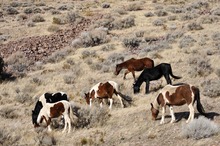The Navajo Nation says it will end its wild horse roundups and reverse its public support for a return to domestic horse slaughter following talks with former New Mexico Gov. Bill Richardson this past week.

Working together to manage wild horse population
Ben Shelly of Navajo Nation has agreed to work with Robert Redford and Governor Bill Richardson and their Foundation to Protect Wild Animals to develop humane ways to manage wild horse population.
© 2013 by Carien Schippers
Navajo Nation President Ben Shelly said that he met with Richardson over the weekend and they agreed to work together to find more long-term and humane solutions to the horse overpopulation problem.
The Foundation to Protect Wild Life was formed by Governor Richardson and actor Robert Redford this summer to fight efforts by a Roswell, N.M., company and others to slaughter horses.
Previously, the Navajo Nation which says it has 75,000 feral horses drinking wells dry and causing ecological damage to the drought-stricken range has been rounding up and selling horses, knowing some would likely make their way to horse slaughter plants south of the border.
But in a statement issued Tuesday, Shelly said the tribe will pull back its support for the New Mexico slaughter plant and suspend horse round ups while it works with the foundation and other groups to develop and implement alternative policies to manage feral horse populations. Possible solutions include equine birth control, adoption, land management and public education.
Richardson said that persuading Shelly to change his position on horse round ups and slaughter “is exactly the outcome horse advocates, such as myself, had hoped for.”
Congress effectively banned horse slaughter by cutting funding for plant inspectors in 2006. The ban was lifted in 2011, and Valley Meat Co. has been battling ever since for permission to open its converted cattle slaughterhouse. The USDA issued a permit this summer, but litigation by animal protection groups has delayed its planned August opening.
The return to domestic slaughter has divided horse rescue and animal welfare groups, ranchers, politicians and Indian tribes about what is the most humane way to deal with the country’s horse overpopulation. Much of the debate also focuses on whether they are companion animals or livestock.
Supporters of a return to domestic horse slaughter argue that it is a more humane solution than shipping unhealthy and starving animals south of the border to facilities with unregulated and often cruel circumstances.
Opponents have been pushing for a ban that would also outlaw the shipment of horses across the border.
